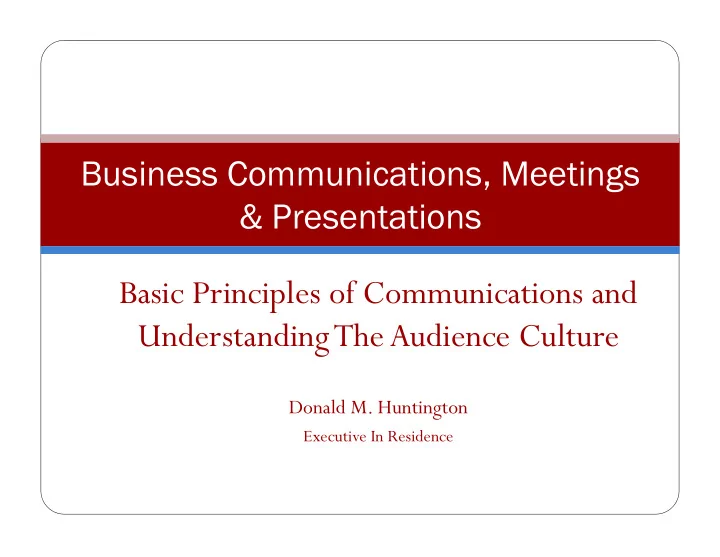

Business Communications, Meetings & Presentations Basic Principles of Communications and Understanding The Audience Culture Donald M. Huntington Executive In Residence
What is Communication? Two-way process Sending & receiving information Through one or many channels
Communication is Active, not Passive. Receiver acknowledges receipt. Sender verifies clarity.
For effective communication… The sender must ask for confirmation that the message being sent is being received The receiver must seek clarification and confirm receipt
Leading cause of communication breakdown… Failure of sender to verify receipt and clarify understanding It’s ultimately the sender’s responsibility! That’s not what I I told you heard. what to do .
Barriers to effective communication Environmental factors Room temperature, lighting, noise, chairs, etc. Outside distractions Credibility/reputation of the communicator Appearance, style & authority of the communicator Language, sound, visual presentation Internal factors Worry Fear Deadlines Illness, etc.
Barriers to effective communication Filters Experiences Perspectives Knowledge Opinions What we have here is a failure to communicate .
Sound principles improve chances for success Know your audience Know your purpose (What, why, intended effect?) Know your topic Present a balanced case Be credible Anticipate questions and objections
Sound principles for effective communication Follow through on what you say Communicate in “bite-sized chunks” Present information in several ways Use multiple communication techniques Develop effective ways to get feedback
Understanding the audience culture is critical Who are the key audience members? Who are the decision makers? What’s the audience’s experience with the subject? What are their attitudes? Friendly, neutral, hostile? Are they formal or informal? What networks are they members of? What benefits can I offer them? What objections can I anticipate?
Understanding the company culture is a matter of survival What is the protocol for calling meetings and sending invitations? What is acceptable arrival time at meetings? What is appropriate attire? What is the dominant email style? What is acceptable response time to email and phone messages? Be a ale lert t to c cult lture a and nd c customs ms. . Ig Igno nore a at y your o own p n peril! l!
Use multiple media to enhance effective communication People remember: 10% of what they read only 20% of what they hear only 30% of what they see only 40% of what they hear and see Over 50% of what they hear, see and repeat (repeat = feedback)
Repeat after me… “People remember over 50% of what they hear, see and repeat.”
What was that? “People………..”
Great communicators… Seek non-verbal and verbal feedback Head nods, smiles, confirming comments, quizzical looks, questions Ask for confirmation “Am I being clear? What did you understand me to say?” “If you had to explain this to Bob, what would you say?”
How to be a good listener
Effective communication requires “Active Listening” “Hearing” is a passive activity - it’s not “listening” All parties to effective communication (both senders & receivers) must be active participants That is, they must be completely engaged in the communication
Specific skills can enhance active listening Get the complete message. Be patient. Demonstrate alertness – eye contact, posture, expressions Focus on the message, not the form (voice, mannerisms, dress) Filter out emotionally-charged language and the emotions they trigger in you
Use your brain wisely Use excess mental capacity productively Speaking rate = 100 to 200 wpm Thinking rate = 400 to 600 wpm Think efficiently and critically Mentally review and recap to stay focused on listening What evidence is being given? What assumptions are being made? What’s the effect on me? Are good examples being used? What are the main points I should take away?
Great listeners… Provide non-verbal and verbal feedback Head nods, smiles, confirming comments, quizzical looks, questions Are specific “This is what I think you’re saying. Is that right?” Give actionable feedback (avoid criticism about things beyond control)
Tips & warnings Avoid mental debate Don’t form premature conclusions PAY ATTENTION! There will be plenty of time to analyze later.
Now that you know some important principles of communication…
Recommend
More recommend